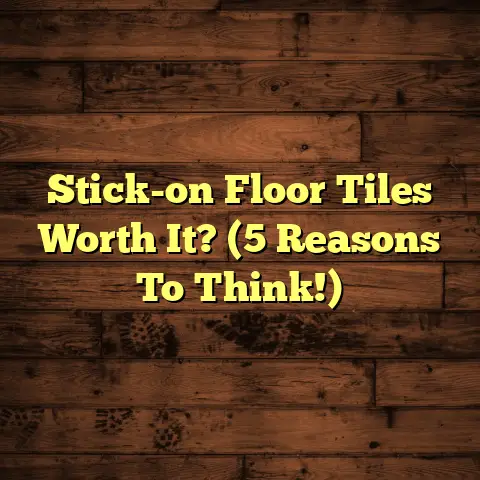Non-Toxic Kid’s Foam Floors? (5 Toxins!)
As a flooring contractor, I’ve seen countless playrooms and daycare centers. One thing’s for sure: kids need a safe space to explore and grow.
And that starts from the ground up!
Parents and caregivers are becoming increasingly aware of the materials used in children’s products. We all want what’s best for our little ones, right?
That includes making sure their play areas are free from harmful chemicals. Foam flooring is a popular choice for kids.
It’s comfy, supportive, and adds a splash of color. Plus, it’s lightweight and easy to install.
But here’s the thing: not all foam flooring is created equal. Some contain toxins that can be harmful to children.
That’s why I’m here to guide you through the world of non-toxic foam flooring. We’ll explore the common toxins lurking in traditional foam products.
And I’ll show you how to choose safer alternatives. Let’s dive in and create a healthy play environment for our kids!
Section 1: Understanding Foam Flooring
So, what exactly is foam flooring? It’s a type of flooring made from, well, foam!
It’s typically used in areas where kids play, such as playrooms, nurseries, and even schools. I’ve installed it in all sorts of places.
You’ll find it in a few different forms:
- Interlocking Tiles: These are like puzzle pieces that fit together.
- Roll-Out Mats: These are larger mats that you simply unroll and lay down.
- Puzzle Pieces: Similar to interlocking tiles, but often smaller and more colorful.
Why is foam flooring so popular? It’s all about the benefits!
First off, it’s fantastic at absorbing impact. Think about all the tumbles and falls that happen during playtime.
Foam flooring cushions those falls and helps prevent injuries. Believe me, I’ve seen it in action!
It’s also easy to clean. Spills and messes are no match for a damp cloth and some mild soap.
And let’s not forget the fun designs and colors. Foam flooring can brighten up any room and make it more inviting for kids.
Plus, it’s relatively inexpensive and easy to install compared to other types of flooring.
Section 2: Common Toxins Found in Foam Flooring
Okay, let’s get to the nitty-gritty. It’s crucial to understand the potential toxins that can be found in foam flooring.
I’m going to walk you through five of the most common offenders. Knowing about these toxins will empower you to make informed choices.
1. Formaldehyde
Formaldehyde is a chemical used in many manufacturing processes. It can be found in some foam flooring as a result of the materials used or the adhesives applied.
Even small amounts of formaldehyde can cause health problems. Kids are especially vulnerable.
Exposure to formaldehyde can lead to respiratory issues, skin irritation, and even certain types of cancer. According to the National Cancer Institute, formaldehyde is classified as a known human carcinogen.
Non-toxic foam flooring options minimize or eliminate formaldehyde by using alternative materials and adhesives. When shopping, look for products that are labeled “formaldehyde-free.”
2. Phthalates
Phthalates are chemicals added to plastics to make them more flexible. They’re often found in PVC foam flooring.
The problem? Phthalates can disrupt hormones and potentially cause developmental issues, especially in young children.
Studies have linked phthalate exposure to reproductive problems, asthma, and other health concerns. The CDC has information on phthalates and their potential health effects.
Fortunately, many non-toxic foam flooring options use safer alternatives to phthalates. Look for products labeled “phthalate-free” to ensure you’re making a safe choice.
3. BPA (Bisphenol A)
BPA is another chemical that’s used in the production of some plastics. While it’s less common in foam flooring than phthalates, it’s still worth being aware of.
BPA is an endocrine disruptor, meaning it can interfere with the body’s hormones. This can be particularly concerning for children, as their bodies are still developing.
Concerns about BPA have led to many manufacturers phasing it out of their products. But it’s still essential to check labels and choose BPA-free foam flooring.
4. Lead
Lead is a heavy metal that can be toxic to humans, even in small amounts. While lead paint is a well-known hazard, lead can also be found in some older or imported foam flooring products.
Lead exposure can cause serious health problems, especially in children. It can affect cognitive development, behavior, and even cause neurological damage. The EPA provides information on the dangers of lead exposure.
To protect your kids, it’s crucial to choose lead-free foam flooring. Look for products that have been tested and certified to meet lead safety standards.
5. Flame Retardants
Flame retardants are chemicals added to materials to make them more resistant to fire. While this might sound like a good idea, some flame retardants can be harmful to your health.
Some flame retardants have been linked to respiratory issues, hormone disruption, and even cancer. The Environmental Working Group (EWG) has done extensive research on the dangers of flame retardants.
Non-toxic foam flooring options often use alternative materials that don’t require the use of harmful flame retardants. Look for products that are labeled “flame retardant-free” or that meet specific fire safety standards without the use of toxic chemicals.
Section 3: Identifying Non-Toxic Foam Flooring Options
So, how do you navigate the world of foam flooring and find products that are truly non-toxic? Here are some tips that I always give my clients.
-
Look for Certifications: Certifications are your best friend! They indicate that a product has been tested and meets specific safety standards.
Some certifications to look for include:
- CertiPUR-US: This certification ensures that the foam has been tested for harmful chemicals and meets standards for emissions.
- Greenguard: This certification means the product has low chemical emissions and is safe for indoor use.
- OEKO-TEX Standard 100: This certification ensures that the product has been tested for harmful substances and is safe for contact with skin.
- Read Labels Carefully: Don’t just glance at the label. Take the time to read it thoroughly. Look for information about the materials used and any chemicals that may be present.
Pay attention to phrases like “formaldehyde-free,” “phthalate-free,” “BPA-free,” and “lead-free.” * Research Brands: Some brands are more committed to sustainability and safety than others. Do your research and choose brands that prioritize non-toxic materials.
Read reviews and see what other parents and caregivers have to say about their experiences with different brands. * Consider Third-Party Testing: Look for products that have been tested by independent third-party labs. This adds an extra layer of assurance that the product is safe. * Shop Smart: Where you buy your foam flooring matters. Look for retailers that specialize in eco-friendly and non-toxic products.
You can find non-toxic foam flooring at:
- Online Retailers: Many online retailers offer a wide selection of non-toxic foam flooring options.
- Specialty Stores: Some specialty stores focus on eco-friendly and non-toxic products for kids.
Conclusion
Choosing non-toxic foam flooring is an investment in your children’s health and well-being. While foam flooring offers many benefits, it’s essential to be aware of the potential toxins that can be found in some products.
By understanding the risks and taking the steps to identify safer alternatives, you can create a play environment that is both fun and healthy.
Remember, certifications, label reading, and brand research are your allies in this process. Don’t hesitate to ask questions and seek out information.
Together, we can make informed decisions and protect our children from harmful chemicals. Let’s create a safe and happy space where they can thrive!





